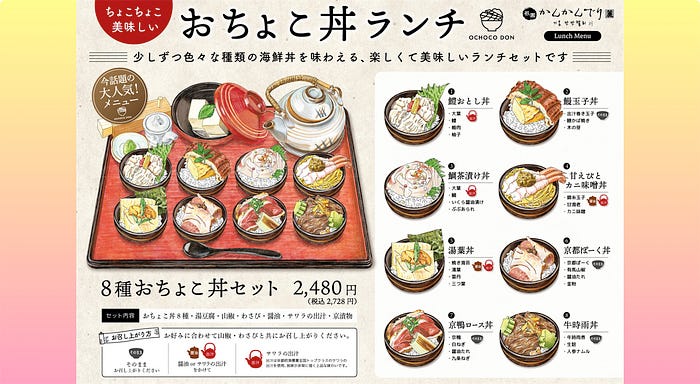Member-only story
Savoring Japan in a Sip: The Rise of Ochoko-Don Cuisine

Last year, the bustling streets of Shibuya, Japan witnessed the emergence of a novel Japanese cuisine, “Ochoko-Don.” Imagine traditional rice dishes elegantly presented in sake cup-sized bowls. Not only did this stylish presentation take social media by storm, but a year into its introduction, numerous variations have flooded the market.
The stark contrast between Ochoko-Don’s unconfined ingredient choices and the meticulous representation of Japanese culinary arts appeals significantly to younger consumers. From eel, sweet shrimp, duck, snapper, to pork, these little bowls dazzle with diverse flavors. In Kyoto, the “Gion Kankanderirei” restaurant has been serving a “Small Bowl Don Lunch Set” since June. University student, Wunai Cai-Cai, who discovered this picturesque meal on Instagram commented, “Although there are eight bowls, the portion size is just perfect.” Each bowl contains roughly 30 grams of rice, almost double that of a traditional sushi.
The restaurant’s owner, Matsura Kojiro, takes pride in Kyoto’s unique ingredients, like yuba (tofu skin) and conger eel. “Drizzling it with mackerel soup accentuates the rich Kyoto flavor,” he shares.

This innovative concept, born in the summer of 2022, was the brainchild of Kobe-based Kaya Group. They launched their pioneering restaurant, “TOKYO FISHERMAN’S WHARF Fish Show” in Shibuya. According to Kaya’s president, Koyama Yu, the inception was serendipitous. “We were brainstorming ways to boost lunchtime patronage when an intern expressed her desire for a dish that was both petite and photogenic.” The idea of the sake cup as a serving vessel came naturally. “The concept of variety in small portions resonated profoundly with young consumers,” noted Yu. But is this truly different from traditional sushi? Yu explains, “That’s precisely why we named it Ochoko-Don. It’s a donburi (rice bowl dish), but in a miniature format.”
Post Kaya’s booming success, many restaurateurs showed interest in this nearly 3,000-yen lunch. However, Yu believed it might be challenging to replicate this success outside Tokyo. Hence, the emphasis shifted to using…
